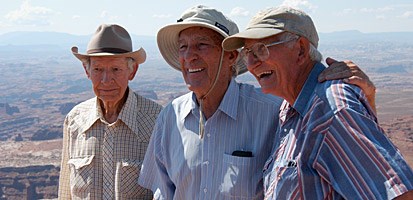
NPS/Neal Herbert Stewart Udall served as secretary of the Interior from 1961 to 1969. He was responsible for much legislation to conserve and protect public lands, including the Wilderness Act, the Endangered Species Preservation Act and the Land and Water Conservation Act. During his tenure, the National Park Service added four national parks, six national monuments, nine recreation areas, 20 historic sites and 56 wildlife refuges. Canyonlands was one of the national parks created during this time. On a flight over this area in the early 1960s, then Bureau of Reclamation Chief Floyd Dominy showed Udall where he wanted to build the "next" big dam: just below the Confluence of the Colorado and Green rivers. But where Dominy saw a reservior, Stewart Udall saw a national park. Speaking at Grand View Point on July 26, 2006, Udall revealed this and other moments as he retold the story of how Canyonlands came to be. Udall died on March 20, 2010. Canyonlands Superintendent Kate Cannon provided a short introduction to this 30-minute presentation (linked below). |
Last updated: April 18, 2025
